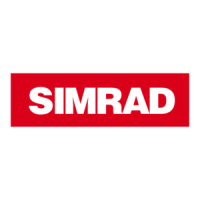SimradSU90
Contributingnoisefactors
Thefollowingfactorsarecontributingtotheperformanceofthehydroacoustic
equipmentusedonboardashingoraresearchvessel:
•thequalityandpropertiesofthetransmittedsignal
•thequalityofthereceivingsystem
•theoperationalsettingsmadeduringoperation
•thepropertiesofthetarget
•thesignal-to-noiseratio
Themajorityofthesefactorscanneitherbecontrollednorimprovedbymeans
ofinstallationmethodsortransducerlocations.Thequalityandpropertiesofthe
transmittingandreceivingsystemsarekeyfactorsduringourproductdevelopment,while
ourenduserdocumentationaimstohelptheusertomaketherightltersettingsduring
operation.Asforthetargetproperties,thereisnothinganyofuscandowiththose.
Thesignal-to-noiseratio,however,canbeimprovedbymakingthecorrectchoices
duringinstallation.
Signal-to-noiseratio(oftenabbreviatedSNRorS/N)isameasureusedinscience
andengineeringthatcomparesthelevelofadesiredsignaltothelevelof
backgroundnoise.Itisdenedastheratioofsignalpowertothenoisepower,often
expressedindecibels.Aratiohigherthan1:1(greaterthan0dB)indicatesmore
signalthannoise.WhileSNRiscommonlyquotedforelectricalsignals,itcan
beappliedtoanyformofsignal[...].
—http://en.wikipedia.org/wiki/Signal_to_noise_ratio(September2013)
Noisesourcesonsonars
Amplifier
A/D
Converter
Signal
processing
(generators,pumps,
refrigeratorsystems,etc)
Flownoise
Acousticnoisefromother
hydroacousticsystem
Propellernoise
Cavitation
Interference
Biologicaldisturbances
Analoguenoise
inamplifiers
Digitalnoise
inanalogueparts
Electricalnoise
frompowersupplies
(CD015904-001)
Foractivesonarandechosoundersystems,thesignalistheechothatwewanttoknow
somethingabout,whilethenoiseisanyunwantedsignalsordisturbances.Theecho
mustbedetectedinthenoiseandthereforeitisnecessarytokeepthenoiselevelisas
48
381293/A

